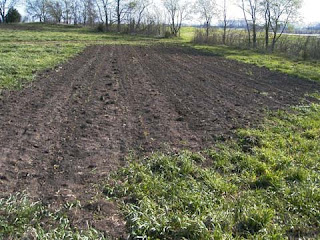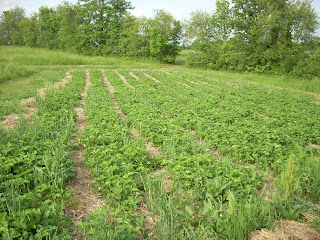TOMATOES (F/P) A few to start the season
CHERRY TOMATOES (F) Our selection of varying colors and flavors, all ripe for eating now
SWISS CHARD: (F/P) Some holes, from bugs of course, but many from our pea-size hail last Weds. morning. Full shares get chard, partials a choice with the cabbage.
TROPEA RED ONIONS (F/P) We’re picking them fresh just like they looked in the markets of Italy. Read Tom’s blog (below) for more info and a recipe.
SUMMER SQUASH: (F/P) The perfect vegetable for every summer dish
CUCUMBERS (F) Still growing sluggishly, for now it’ll be an every other week item.
EARLY JERSEY WAKEFIELD CABBAGE: (F/P) Our favorite cabbage for spring – a sweet pointy-headed heirloom.
GREEN BEANS (P) The end of the first and perhaps a few off the second planting.
HERB CHOICE (F/P) Basil, Parsley or a dried herb.
Also this week: Parker Farm meat and egg share delivery
Next Week: More tomatoes, summer squash, cucumbers, and beans. More garlic and carrots. Maybe the last of the spring beets and some green peppers. Bread of Life bread share delivery.
Summer is truly here. We have finally had some sweaty days out in the fields and do we smell like it! The usual parade of harvest, weed, tie tomatoes, weed, etc continues. We finished seeding most of the fall transplants, caught up on seeding the fall beets, carrots and rutabagas, and got the buckwheat summer cover crop in before the rain tonight.
But the big news on the farm is that the summer favorite, the tomato, h as begun to ripen its fruit. Tomatoes are such an important crop for us that its hard to know where to start in explaining all of the work, joy, sweat and anticipation that goes along with them. Tomatoes are not only critical for the shares but are especially necessary in our household. Sharing my life with Farmer Ruggieri requires a great love for the fruit converted into every imaginable preserved goodie: sauce, ketchup, juice, sun-dried and paste. All this tomato-saving allows us to eat very well all winter long and save our farm income from the grocery store. Of course, nothing compares to eating them fresh, which we also enjoy. Our favorites are the heirlooms in all their varied glory. The Brandywine is pictured. There will be some at distribution, but the most numerous heirloom this week will be the Cherokee Purple – almost brown when ripe and with a smokey flavor. We are handing out the tomatoes in varying stages of ripeness. Take at least one less-ripe one to have later in the week. Rule of thumb: ripe tomatoes are soft and brightly colored, less ripe have areas of green and are hard. Leave on the counter to ripen, never in the fridge.
as begun to ripen its fruit. Tomatoes are such an important crop for us that its hard to know where to start in explaining all of the work, joy, sweat and anticipation that goes along with them. Tomatoes are not only critical for the shares but are especially necessary in our household. Sharing my life with Farmer Ruggieri requires a great love for the fruit converted into every imaginable preserved goodie: sauce, ketchup, juice, sun-dried and paste. All this tomato-saving allows us to eat very well all winter long and save our farm income from the grocery store. Of course, nothing compares to eating them fresh, which we also enjoy. Our favorites are the heirlooms in all their varied glory. The Brandywine is pictured. There will be some at distribution, but the most numerous heirloom this week will be the Cherokee Purple – almost brown when ripe and with a smokey flavor. We are handing out the tomatoes in varying stages of ripeness. Take at least one less-ripe one to have later in the week. Rule of thumb: ripe tomatoes are soft and brightly colored, less ripe have areas of green and are hard. Leave on the counter to ripen, never in the fridge.
We pick all of our tomatoes once they have their first blush of color. The sooner we pick them the less likely someone else will get to them first (i.e. rot, the pests, or …raccoons, yes a few are in the patch despite Rocky’s diligence.) Contrary to popular belief, this does not affect their flavor. The reasons why grocery store tomatoes taste like cardboard include being washed in a chlorine bath, refrigeration (don’t put your tomatoes in the fridge, folks!) and varieties that are bred for long shelf-life. Heirloom tomatoes are thin-skinned, easily bruised and often sport cracking, cat-facing and green shoulders to name a few of their most identifiable conditions. Despite all these disabilities, or maybe because of them, they offer a wide assortment of fabulous flavor, textures and color. If all this makes you a little nostalgic for the lowly red tomato, not to worry. Half of our tomato crop is dedicated to the standard red globes (with a few yellows thrown in) that have that classic, tomato taste and look. Early Girls are predominant this week.
And finally a big bucket of gratitude goes to last Wednesday’s farm crew who slugged it out in the pouring rain to harvest the shares. Linda Coussens, Chris Veach, Linda Williams, Linda Evans, her mother Beverly and Dorris Bender worked through the morning soaking wet and stayed into the afternoon in order to get the beans picked. Cheers to their community spirit!












 Finally some gorgeous spring weather after so much of the cold and muddy. Storms were all around us last week although we missed the deluge that others have seen. The paths we spaded last fall to allow excess water to drain out of the growing beds seem to be working. One place that we hadn’t spaded was in the potato beds, so Thursday we bailed the potato trenches by hand. After moving literally a ton of water, they are now drying out. All of the spring crops are in the fields but growing slowly with the cool temps. Looks like our latest planting of peas rotted, but we’ve got four other beds growing. Now is the time when we begin to fret about whether all of our winter planning combined with the vagaries of climate will lead to the season starting on time. With three weeks away from our planned first distribution, the mood at times is tense. So far, we think we’ll make it. In the meantime, we continue with the spring chores. This week we thinned the direct seeded crops: arugula, beets, chard, rapini, radishes, and turnips.
Finally some gorgeous spring weather after so much of the cold and muddy. Storms were all around us last week although we missed the deluge that others have seen. The paths we spaded last fall to allow excess water to drain out of the growing beds seem to be working. One place that we hadn’t spaded was in the potato beds, so Thursday we bailed the potato trenches by hand. After moving literally a ton of water, they are now drying out. All of the spring crops are in the fields but growing slowly with the cool temps. Looks like our latest planting of peas rotted, but we’ve got four other beds growing. Now is the time when we begin to fret about whether all of our winter planning combined with the vagaries of climate will lead to the season starting on time. With three weeks away from our planned first distribution, the mood at times is tense. So far, we think we’ll make it. In the meantime, we continue with the spring chores. This week we thinned the direct seeded crops: arugula, beets, chard, rapini, radishes, and turnips.

